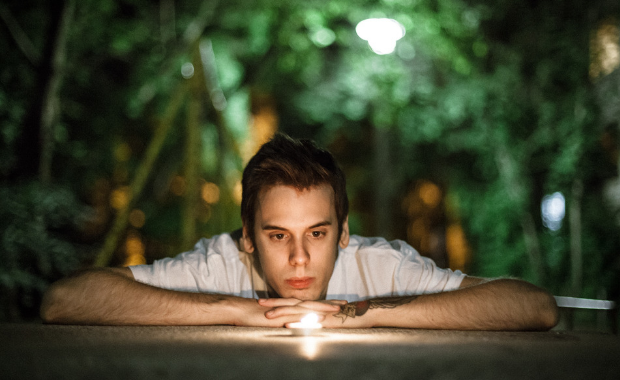Life
Meditation for Beginners: How It Works and Where to Start

Meditation was first developed in India many years ago (around 5000-3500 BCE). It took quite some time to become popular in the western world, but today, it is celebrated as a therapeutic tool to ease stress, anxiety, depression, and addictions. In the past years, it has also become recognized as helping to improve mental performance, and consequently became a multi-billion dollar business. If you’ve never tried it, you may be wondering how something so simple as sitting with your eyes closed could deliver such incredible benefits.
How meditation works
Meditation is about training in awareness and getting a healthy sense of perspective over one’s thoughts. Many think that meditating is about trying to achieve a zen state of mind, but that’s not the point. Observing one’s thoughts, and then letting go of them so that eventually you may start to better understand them, is the real goal of each meditation practice.
There are different techniques to go through this mental process. Some focus on the breath and bodily sensation, others make you visualize an object, and others help you to channel your thoughts towards acts of love and kindness.
A typical meditation session involves you sitting on a chair or cross-legged on the floor with your eyes closed. Once you assume a comfortable position and focus on your breath, you should start noticing your thoughts. At this point, according to what type of technique you’re using, you will try to let those thoughts go away by focusing on something else (this could be your breath or a mental image you created).
With time and practice, you may be able to reach a state of mind where very few thoughts (or none) are present. Despite the simplicity of this process, meditating for more than ten minutes is extremely tough for most. Many people that try meditation get discouraged by the fact that “they can’t stop thinking.” In fact, it has been proven that people spend most of their days being anything but mindful and peaceful.
In a 2010 study, Harvard researchers asked more than 2000 adults about their thoughts and actions at random moments throughout their day via an iPhone app. People’s minds wandered 47% of the time, and mind wandering often triggered unhappiness, the scientists reported.
They also observed that spending time observing our thoughts without getting stuck on them, may help to better understand oneself, and possibly being able to reduce the number of negative thoughts one experiences.
“The mind is definitely something that can be transformed, and meditation is a means to transform it.” – Dalai Lama
What science says about meditation
People have practiced meditation for thousands of years, but scientists have studied its effects for only a dozen. In the past few years, many studies have been published about the neurological benefits of meditation, proving it to improve brain function in many different ways.
Meditation’s benefits range from preserving the aging brain, to improving happiness by reducing the activity of the brain’s “me center” (monkey mind). A more recent study has even proven that meditation is as powerful as antidepressants in treating depression, anxiety, and pain. Many more studies are being conducted every day on meditation, and we can expect to gain a lot more insight in the near future.
Can anyone meditate?
Millions of people are practicing mindfulness meditation every day with great results, but there are also as many people that have tried meditating and didn’t like it or didn’t manage to be consistent with their practice. The most important part of developing a meditation practice is consistency. You don’t have to meditate every single day, but the benefits are tied to regular, consistent practice.
Some studies claim that some benefits of meditation such as improved mood, decreased stress and decreased blood pressure, can be felt after a single session. Some other benefits like increased focus and decreased anxiety may be experienced after a few weeks and others take longer to develop.
Some people claim that as little as five minutes of meditation per day can make miracles, but research shows that a regular practice associated with benefits involves 10-20 minutes of meditation at least three times per week.
“Be happy in the moment, that’s enough. Each moment is all we need, not more.” – Mother Teresa
What’s the best way to begin a meditation practice?
A good place to start for aspiring mediators is Headspace. Andy Puddicombe, a former English student in sport science, dropped his studies to travel to Asia and trained as a Buddhist monk. He created Headspace with the goal of helping millions of people to live a more mindful life. Over 30 million people have downloaded and use headspace. This is due to his simplicity and its beautiful design and animations.
Do you meditate? If so, what’s your favorite aspect of it? Share your thoughts below!
Life
Imposter Syndrome Is Rooted in Your Past But Here’s How You Can Rewire It
Imposter syndrome is most prevalent in highly successful women

Imposter syndrome is “the persistent inability to believe that one’s success is deserved or has been legitimately achieved as a result of one’s own efforts or skills.” (more…)
Life
The Surprising Mental Health Tool You Probably Haven’t Tried
Through journaling, I arrived at a more balanced perspective, it reinstated my sense of gratitude and led me to accept my disability

In two particularly difficult times in my adult life, my journaling practice is helping me heal emotionally. It has been a vital tool for helping me see the bigger picture and land in a place of gratitude. (more…)
Life
How to Stop Comparing Yourself to Others and Find True Happiness
Comparison is the thief of joy; it robs us of our happiness, self-esteem, and peace of mind

In today’s hyperconnected world, it’s easier than ever to fall into the trap of comparing ourselves to others. Social media platforms like Instagram, Facebook, and LinkedIn constantly bombard us with curated highlights of other people’s lives, making it seem like everyone else is happier, more successful, and more fulfilled than we are. (more…)
Life
Harness the ‘Battery Effect’ to Transform Life’s Tensions into Your Greatest Strength
Recharge your life batteries by shifting your mindset today

I believe our life capacity is determined by the skillsets we develop on this spinning rock we call Earth. By “life capacity,” I mean our ability to embrace and sustain joy. (more…)
-

 Success Advice4 weeks ago
Success Advice4 weeks agoThe One Mindset Shift That Made Me Irreplaceable At Work
-

 Did You Know3 weeks ago
Did You Know3 weeks ago7 Surprising Life Lessons Video Games Taught Me That School Never Did
-

 Success Advice3 weeks ago
Success Advice3 weeks agoHow Playing by the Rules Became the Smartest Business Strategy
-

 Success Advice3 weeks ago
Success Advice3 weeks agoHow to Build Trust, Kill Micromanagement, and Lead a Team That Thrives
-

 Scale Your Business3 weeks ago
Scale Your Business3 weeks agoHow to Build a Workplace People Actually Want to Show Up To
-

 Success Advice2 weeks ago
Success Advice2 weeks agoSuccess Isn’t Sexy: 5 Daily Habits That Actually Work
-

 Scale Your Business2 weeks ago
Scale Your Business2 weeks agoHow Smart Entrepreneurs Cut Financial Chaos in Half with One Simple Switch
-

 Success Advice2 weeks ago
Success Advice2 weeks agoBreaking the Bias: How Females Can Thrive In The Workplace in 2025






























2 Comments